 |
Related pages: |
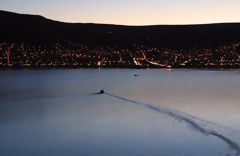 Puno
was the siege of one of the most important civilizations of the pre-Inca period,
the Tiawanaco culture, the supreme expression of the ancient Aymara
people, whose remains arouse admiration.
Puno
was the siege of one of the most important civilizations of the pre-Inca period,
the Tiawanaco culture, the supreme expression of the ancient Aymara
people, whose remains arouse admiration.
According to the legend, the first Inca, Manco Cápac, and his wife, Mama Ocllo, emerged from the Titicaca Lake. Their father, the Sun God, ordered them the foundation of the Empire, or Tawantisuyo, which was divided in four regions, Puno occupied the Collasuyo region that consisted of the whole Collao high-plateau.
When they arrived to Cuzco, around half 16th century, Spanish found the great mining wealth of the region, especially in gold and silver.
In 1660, bloody fights for the possessions of a very rich mine in Laikakota, near the actual city of Puno, forced the vice-monarch Count de Lemos to go to the area to bring peace; this was at the origin of the foundation of the actual city of Puno, on November 4th, 1668. Spanish priests, because of their eagerness to evangelize aboriginal populations, made build beautiful churches, in which the imagination and dexterity of the people of Puno shaped their own half-caste style.
The Puno department has two distinct seasons: humid (December to April) and dry (May to September). Days are temperate and nights cold (8°).
Now Puno is an important agricultural and cattle and camels breeding region.
Located on the Titicaca side, the city isn't very beautiful, but we forget it because of the lake. At 3.810 m of altitude, days are sunny, with a cool air like on the mountains. On the other hand, it freezes at night and sky is fantastically starry. Sunrises on the Titicaca are worthy, Hollywood style. Altitude means also that you have to avoid intense physical efforts, long walks. In the Andes region men have a superior model of rib cage, with extra red corpuscles, which explains also their purplish cheeks.
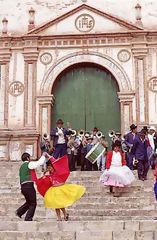 Its construction dates from the 18th century and was made in stone by the Peruvian
Simón de Asto, whose name is written on the door. In a baroque style,
it constitutes an example of local half-caste architecture.
Its construction dates from the 18th century and was made in stone by the Peruvian
Simón de Asto, whose name is written on the door. In a baroque style,
it constitutes an example of local half-caste architecture.
At the corner of Deustua and El Conde de Lemos Streets, they say that in this house lived the vice-monarch with the same name when he arrived to Puno in 1768.
At the number 289 of Conde de Lemos Street, we can discover a collection of pottery, goldsmith's art, fabrics and stone sculptures that belong to the pre-Inca and Inca periods. We can see also a numismatic collection and documents about the history of the Spanish foundation of the city of Puno.
Made if carved stone, it was built by Puno people to honor patriots who died for freedom.
Located at 257, Deza St., we can find textile handcraft and religious pottery.
At the west of the city. On the summit is the Manco Capac's monument. From there you can have superb panoramic view, the city of Puno and the Titicaca Lake.
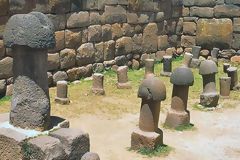 At
18 km to the north of Puno, this town has a beautiful main square with
the Asunción church (1601). It's one of the oldest and most representative
villages from the colonization.
At
18 km to the north of Puno, this town has a beautiful main square with
the Asunción church (1601). It's one of the oldest and most representative
villages from the colonization.
Chucuíto has something that only imprudent locals will tell you about and any agency proposes. There is here a rectangular building with two walls of two meters of height, apparently from the Tiwanaku culture, of about 100 or 150 sq. m., with an entry full of... stone penises. You could think that small ones are mushrooms, but the one in the center is one meter tall, you can't miss it. Locals will tell you that women must seat on the big in order to have painless childbirths, or just to be able to have children. Nobody seems to know anything about this and, even if the visit takes only 10 or 15 min., it is worth it.
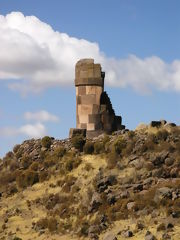 At 30 km to the north of Puno, on the shore of Umayo Lake, this
place has monuments called Chulpas, circular stone constructions, which
the height varies from 10 to 13 m. They suppose these were tombs of Hatumcollas
leaders.
At 30 km to the north of Puno, on the shore of Umayo Lake, this
place has monuments called Chulpas, circular stone constructions, which
the height varies from 10 to 13 m. They suppose these were tombs of Hatumcollas
leaders.
At 75 km from Puno, famous for its potteries. From this place come Toritos de Pucará.
At 53 km from Puno, interesting town for the churches we can find.
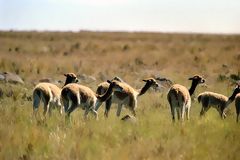 In the province of Azangaro, at 4 hours to the north of Puno,
we find the installations and equipment for the breeding, the protection and
reproduction of these camels.
In the province of Azangaro, at 4 hours to the north of Puno,
we find the installations and equipment for the breeding, the protection and
reproduction of these camels.